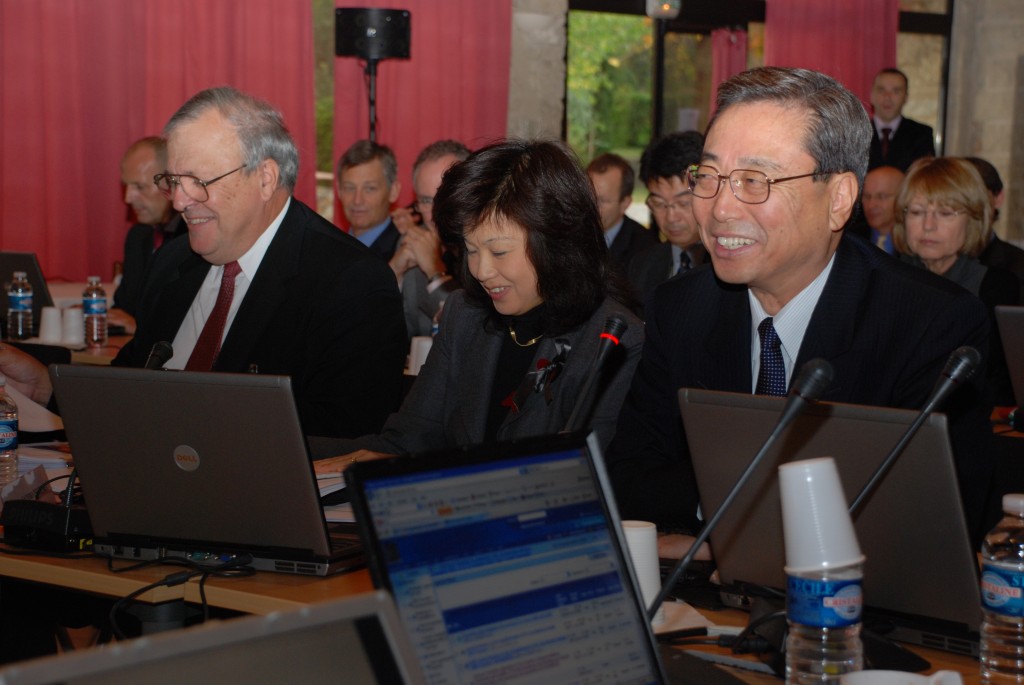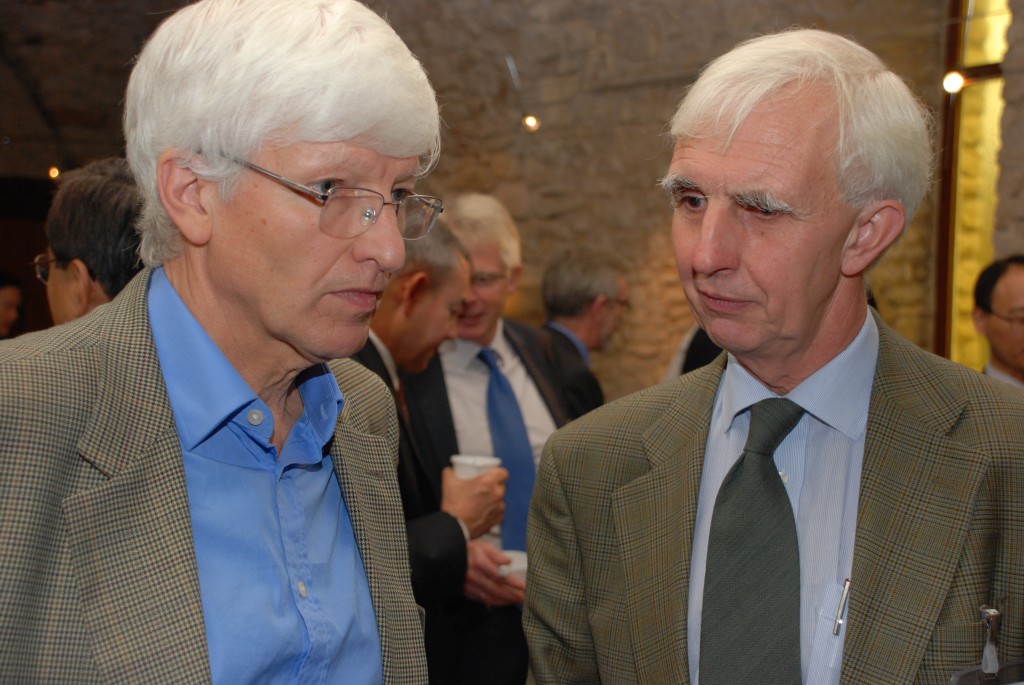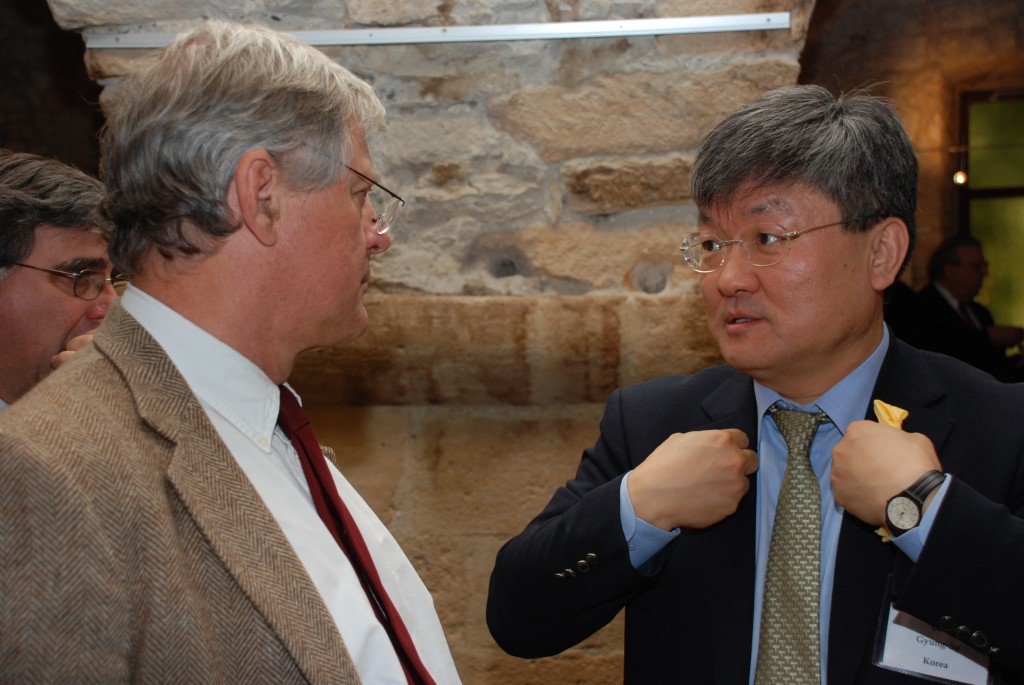ITER NEWSLINE
56
The MAC factor
Sabina Griffith

Chairman of the MAC, Bob Iotti; Council Secretary, Sachiko Ishizaka; and ITER Director-General, Kaname Ikeda.

Sir Chris Llewellyn Smith, Chair of the ITER Council, talking to Frank Briscoe, the leader of the "Briscoe Panel."

US ITER Head Ned Sauthoff, speaking with GS Lee, the former Head of ITER Korea, now president of the National Fusion Research Institute.
It is the morning of the MAC, the Management Advisory Committee to the ITER Council that is about to start. New tables and chairs have been installed in the Salle de la Fenière for this occasion, but still there is not enough seating for all delegates and observers. This MAC meeting is certainly one of the biggest meetings the room has seen for a while. Additional tables are quickly brought in before Bob Iotti, the MAC Chairman, calls the meeting to order. A meeting, Iotti says, whose importance is underlined by the presence of the Chairman of the ITER Council, Sir Chris Llewellyn Smith, and the exceptionally high number of delegates from each party.
On 24 October 2007, the ITER Organization celebrated its birth with a modest but exuberant party in front of the Joint Work Site in Cadarache. The seven Domestic Agencies of the ITER Members participated via a live video link. Spirits were high; it was the start of something big.
One year later, it's still big and there's a much better understanding of just how big and challenging it is in reality. "This is the time to get the project up and running," the Council Chairman states. "We have to get on with this!" He expresses a feeling that everybody shares and the next few days are spent on exactly how that is going to happen.
The ITER Project has made considerable progress over the past year: the Organization has grown from 153 staff members in October 2007 to 276 today. As we set up the management and organizational structure, the nuclear licensing process is also well on its way, as well as the preparations for the start of construction next year. In parallel, a comprehensive review of the 2001 ITER design has been carried out with all seven parties heavily engaged. Multiple design change requests and some major technical improvements like additional coils to improve the control of ELMs (edge localized modes) and the vertical stability of the plasma, a complete new design for the hot cell and so on have been proposed for inclusion in the new 2007 baseline. They are all necessary and help to make sure that ITER can safely fulfil its scientific and technical mission. Everybody agreed and the Council approved the technical baseline in its last meeting in June.
These design changes, the changes in the Organization's set-up since the first negotiations in 2001, the unprecedented increases in commodity prices, and the fact that more parties do need more people to manage the interfaces in the ITER Organization all imply a substantial cost increase. In order to get a more solid prediction of how big this increase will be, the ITER Council asked for an estimate by the ITER Organization and at its last meeting in Aomori, Japan, in June this year charged the well-known fusion scientist and former Operations Director at the UK's fusion centre at Culham, Frank Briscoe, with setting up an independent panel of experts to assess the resource estimates.
He shows the ITER Tokamak as a logo on every single slide "to remind us of the importance of what we are doing here at ITER." The so-called "Briscoe panel" consists of 17 experts, at least one from each ITER Party, plus three advisers. Some of the panel members are fusion scientists, some have no scientific background at all. "But they all have good knowledge of big projects," says Briscoe. "It is a good mix." In two four-day meetings the Briscoe team went through the ITER figures—at least as far as possible within the given time. "ITER is a huge endeavour. It was impossible to assess all open issues within eight days." Another round of reviews will likely happen in spring of 2009.
So the summary Briscoe gives to MAC this Wednesday morning is only preliminary with regard to the conclusion on numbers. For the time being, 36 recommendations were made—some of them "very much straightforward"—namely to produce a more effective management system and well-founded cost and schedule to be presented to the MAC. The outcome will be discussed by the ITER Council in a few weeks.The MAC members further agree to support the effort of the ITER Organization in implementing the recommendations given by the Briscoe panel.
Besides the ongoing cost assessment, the question of how to effectively operate this construction project based on "in-kind" contributions was a central theme for much of the meeting. Although not completely new, at the scale of ITER this concept is unprecedented. Finishing Procurement Arrangements, which are agreements between the ITER Organization and the Domestic Agencies to deliver components, become a key indicator for success on the schedule and—looking at a traffic light system representing their status—there is as much red as there is green to be seen on the slides. The Chair explains that there is no need to change the schedule yet, but its certainly requires very close attention.
"The clock ticks and the money runs," Norbert Holtkamp, the Principal Deputy Director-General, points out. "It is as simple as that." The ITER Organization and the Domestic Agencies have set up recovery plans to make up for the lost time but its not obvious that this can be achieved easily and why not remains to be discussed in the MAC. For the first time the heads of the Domestic Agencies have joined together to explain where some of the reasons for their difficulties lie.
Didier Gambier, the Director of the European Domestic Agency in Barcelona, is the first to take hold of the microphone. "The ITER Organization has the responsibility for the ITER design. But the Domestic Agencies have the money. And money talks!" Ned Sauthoff, head of US ITER, agrees with his European colleague: "This is not a normal project. The ITER principle foresees significant in-kind contributions and the Domestic Agencies hold considerable resources. We thus have to find the right balance."
Making the ITER Organization and Domestic Agencies work as an integrated team has been a long-standing recommendation by the MAC, and that means finding the balance between sharing responsibility and authority. The ITER Organization and the Domestic Agencies propose the implementation of Integrated Product Teams and a structure above them that allows effective management. The MAC in its subsequent conclusions strongly supports the ITER Organization to put the three teams in place "as soon as possible." Even though the MAC members agree, one question remains: "Will it work?"
This is the moment for the Chairman of the ITER Council to get back on stage: "The lawyers will certainly have to look at this," says Chris Llewellyn Smith. "But if this is the right tool to make ITER work, then I am sure it will be perfectly legal to find an interpretation of the document. I have no doubt about that. The true answer lies in the willingness of this global collaboration. It will not work if there is no good will."
On the second day of the MAC, the sun shines again. Another round of difficult discussions has finished and a solution is in sight. Success of its implementation will be measured in six months from now and more guidance from the ITER Council will be received in three weeks. Meanwhile the ITER Organization and the Domestic Agencies are already working to get the answers. A long week ends with the ITER Organization-Domestic Agency coordination meeting on Sunday, where the people in the room feel the burden, recognizing that much of what was discussed will dominate their working days over the next six months. And they won't be short days, everybody has understood that.
See some photos of the meeting here...
return to Newsline #56




